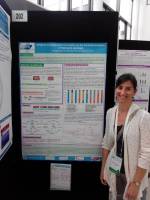Amélie Rouger a brillamment présenté une communication orale sur les écosystèmes microbiens de la viande de poulet dans la session « Food spoilage » . Cela lui a valu le premier prix de la communication orale !
Understanding bacterial community dynamics to improve the quality of poultry meat during refrigerated storage
Amélie Rouger1,2, Jenni Hultman3, Benoît Remenant1,2, Hervé Prévost1,2, Johanna Björkroth3, Monique Zagorec1,2
1INRA, UMR 1014 Secalim, Nantes, F-44307, France.
2 LUNAM Université, Oniris, Nantes, F-44307, France.
3 Faculty of Veterinary Medicine, Department of Food Hygiene and Environmental Health, Helsinki, Finland
Controlling spoilage microorganisms, especially in raw meat products, is challenging the food industry. The nature of microbial communities contaminating meat, and their development vary depending on seasonal changes and production processes, such as marinating or modified atmosphere packaging.
Interactions between food microorganisms should be studied further to be able to improve the quality of fresh meat. With the recent development of next generation sequencing methods used in characterizing different ecosystems, we decided to utilize them for studying bacterial community dynamics during meat storage.
We first developed a method generating reproducible chicken meat ecosystems with known bacterial communities described by 16S rRNA gene pyrosequencing. Of these, we selected two bacterial communities with predominance of either Brochothrix thermosphacta or Pseudomonas spp. to be used in reproducible challenge tests on meat stored under different modified atmosphere packaging conditions.
Among 23 different meat bacterial communities collected, culture-based methods showed that lactic acid bacteria, B. thermosphacta, and Pseudomonas spp. were dominating. The 16S rRNA sequencing data confirmed the presence of B. thermosphacta, and suggested that the Pseudomonas group detected was mainly consisting of P. extremaustralis and P. cedrina. The other species found were Shewanella species and lactic acid bacteria as Carnobacterium. The predominance of Pseudomonas was correlating with packaging under high oxygen concentration, except when B. thermosphacta was dominant, suggesting a competition between these species.
Bacterial communities stored frozen were shown to be able to overgrow the initial natural contaminating microbes enabling reproducible challenge tests. Metatranscriptomic and metagenomic analyses are in progress to evaluate the impact of storage atmosphere on the community dynamics of these bacteria and on the functions the bacteria express depending on the storage condition and on the nature of bacterial communities present. This will lead to gain indications to optimize packaging of poultry meat by managing their ecosystems.
Key-words : Food spoilage, Poultry meat, Metagenomic, Metatranscriptomic, Bacterial interactions
Secalim était également présent pour une keynote présentée par Jeanne-Marie Membré et deux posters présentés par Agnès Bouju et Nassima Illikoud.
- Jeanne-Marie Membré a été invitée pour une communication intitulée « Meta-analysis for growth and survival data ».
- Deux posters ont été présentés dans la session « Food Spoilage » le 21 juillet 2016 par Agnès Bouju sur les écosystèmes bactériens de saucisses de porc et par Nassima Illikoud sur la diversité phénotypique et génotypique de Brochothrix thermosphacta
Plus de renseignements sur le congrès à l’adresse suivante : http://www.foodmicro2016.com/
Influence of preservative formulation on the bacterial ecosystem of fresh pork sausages
Agnès Bouju1,2, Sandrine Guillou1,2, Benoit Remenant2,1, Marie-France Pilet1,2
1 LUNAM Université, Oniris, F-44307 Nantes,
2 INRA, UMR1014 SECALIM, F-44307 Nantes,
To meet consumer demand for reduction of preservatives in food, industrials have to find alternative strategies using different formulations, natural antimicrobials or bioprotective flora. The ultimate purpose is to apply these techniques to preservative-free meat products like fresh pork sausages to guarantee the same shelf-life as in the current formulation containing preservatives (potassium lactate, sodium acetate). These solutions may have different impact on the microbial quality of the product. To that aim, the bacterial communities were characterized in two formulations containing preservatives or not. Conventional microbiological analysis and high-throughoutput 16S rDNA amplicons sequencing method were performed in several meat batches conditioned under modified atmosphere (70% oxygen; 30% carbon dioxide) at different chilled storage times. In addition, meat pH and color, and gas composition of the packaging headspace were monitored until the end of the shelf-life.
During chilled storage, whatever the formulation, populations of Pseudomonadaceae and Enterobacteriaceae were maintained, whereas the mesophilic flora, Brochothrix thermosphacta and lactic acid bacteria were shown to increase. The physicochemical parameters (pH, package gas composition) similarly evolved during chilled storage, mainly resulting from bacterial metabolism. Hence they have failed to convey differences in sensorial alteration perceptible at the end of the shelf-life.
At the end of the shelf-life, in both formulations, lactic acid bacteria were the most represented bacteria in meat. Principal Component Analysis enabled to show that the most represented species in the formulation with preservatives were Lactobacillus curvatus/graminis, Leuconostoc mesenteroides and Leuconostoc carnosum. In the preservative-free formulation, higher microbial variability was observed. However Lactobacillus fuchuensis, Lactobacillus oligofermentans and Brochothrix thermosphacta seemed to prevail in some samples.
Although slight differences were observed between both formulations, preservatives seemed to limit Brochothrix development by promoting a selection pressure towards Lactobacillus curvatus/graminis and Leuconostoc mesenteroides. The latter could represent good candidates for bioprotective flora.
Keywords: Meat, preservatives, microbial ecosystem, spoilage, high-throughoutput 16S rDNA sequencing
Diversity of Brochothrix thermosphacta and food spoilage
Nassima Illikoud1,2, Emmanuel Jaffrès1,2, Marie-France Pilet1,2, Romain Chauvet3, Thomas Charrier3, Monique Zagorec1,2
1 INRA, UMR1014 SECALIM, F-44307 Nantes,
2 LUNAM Université, Oniris, F-44307 Nantes,
3 EUROFINS, Laboratoire Microbiologie Ouest (ELMO), F-44300 Nantes.
Understanding and controlling food spoilage represent a scientific, economic, and ecological challenge: approximately 1/3 of food production is lost every year mainly due to microbial spoilage. Bacteria responsible for spoilage are diverse and their spoiling ability is strain-dependent. Brochothrix thermosphacta is one of the most frequently encountered bacterium associated with food spoilage, especially of vacuum-packed or under modified atmosphere meat and seafood products. Its main activity on these products is the production of metabolites, including acetoin / diacetyl, responsible for buttery odor. Although this species was isolated from a wide variety of spoiled or non-spoiled food matrices, few studies have focused on the diversity of metabolic and spoiling activities within this species. We evaluated the phenotypic and genotypic diversity of B. thermosphacta isolates, issued from various ecological origins. A collection of 159 strains, isolated from bovine slaughterhouse environment and different food matrices (milk, pork/beef/lamb/horse/poultry meats, and seafood products), was constituted from various laboratory collections. Strains were typed by rep-PCR (repetitive element palindromic PCR), PFGE (Pulsed-Field Gel Electrophoresis), and MALDI-TOF (Matrix-Assisted Laser Desorption / Ionization Time-Of-Flight). The results obtained by each technique separated strains into distinct groups, revealing significant genetic diversity within the strain collection. No clear correlation was observed between the results obtained with the three methods. The intra-species diversity does not seem to be related to the environment in which the strains were isolated from. In other words no ecotype (strains sharing the same ecological niche) was observed. The ability to produce acetoin / diacetyl in liquid laboratory medium was variable between strains. These results suggest that spoiling ability of B. thermosphacta is correlated to strain properties rather than to the food environment. Rep-PCR, MALDI-TOF and PFGE clustering confronted to spoilage properties of B. thermosphacta isolates will be used to select a sub-set of distant strains for genome comparison.
Keywords: Brochothrix thermosphacta, spoilage, off-odors, genotypic diversity, food matrices.




